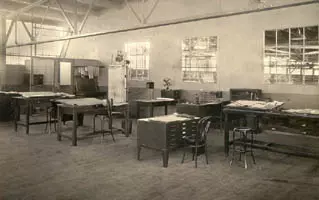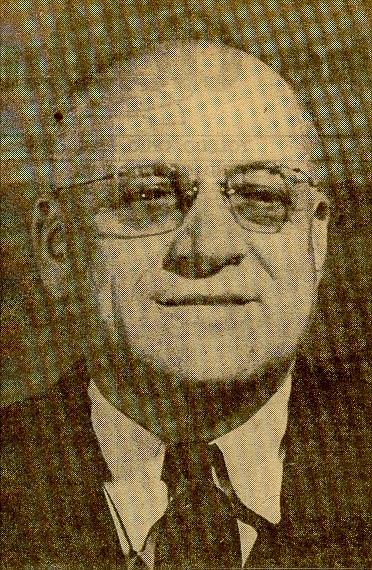II. The Depression -- "...during the Depression we got paid by Brinks Express, and was only paid $10.00. If we had more coming it was owed us..." -Frank Glyda, press operator, as quoted in The Acklin Press, 1975.
A. Toledo During the Depression
In the spring of 1929, Willys-Overland laid off the first of several thousand workers, bringing the abstract idea of the collapse of the New York Stock Exchange’s house of cards into sharp reality in the Toledo area. Willys-Overland was a major economic force in the Toledo area; the company’s $27 million payroll in 1925 represented about 41% of the city’s total annual payroll. The 1929 layoffs forced thousands of people into poverty, pushing the numbers of individuals receiving direct federal assistance to record highs. Although the jobless rate in Ohio reached 37%, in Toledo that number was nearly 80%.
The economic panic hurt many small companies and shops, forcing some to close and most to cut back workers. Acklin, however, though forced to lay off a fairly large number of workers, managed to keep its doors open and within a few years regained profitability.
The company’s president, James Acklin, met the demands of the economic crisis in a unique way. In October of 1930, he participated in a round table discussion for Iron Age magazine, as his company, like the rest of the industry, was coming to terms with their shared difficulties. During the course of this discussion James mentioned that, from his perspective, the depression had forced the company to become more efficient. He and his employees developed several radically new ideas in an effort to keep overhead at a minimum. One of these ideas included the shifting of presses around the plant's floor in order to allow the same operator to run several presses at once. Previously, presses had remained stationary and workers were used to take parts from one station to the next as it went through its production cycle. But what James and his engineers and employees developed moved these presses together, eliminating the need for workers to transfer parts by hand.
This re-combination of presses would occur for every new job the company received and could happen as often as 3 or 4 times a month. This innovation would be replicated during the next 30 years through increasingly mechanized presses, but at the time the innovation was a new one for the metal stamping industry. James went on to publish an article on the subject entitled “Migration of Presses Into Grouped Units” in the November, 1930 issue of Iron Age.
B. Employee's Tales of the Depression
The depression hit the company as hard as it hit the rest of the country. Jobs were scarce, but Acklin did better than many similar companies in the area. Homer Percival, a machine repairman for the Toledo Machine and Tool Company, was reduced to half time in 1929 following the stock market crash. In early 1930, Mr. Percival was sent to Acklin to repair a press. Since he could only work half days, it took him nearly a month to complete. On his last day, while heading for the door, James Acklin stopped him and offered him a full time position. Homer Percival accepted and remained at Acklin for the next 35 years, actively involving himself in the company and eventually becoming Acklin's general production foreman during the 1950s.
Frank Glyda, in the September-October 1975 issue of the Acklin Press, remembers his days at Acklin during the Depression. He was hired in 1929 and started on the presses earning 45 cents an hour. This dropped to 40 cents an hour in the early 30s. "During the Depression," he said, "we got paid by Brinks Express, and was [sic] only paid $10.00. If we had more coming, it was owed us. In fact, we could not exceed $10.00 per week." He also recalled never knowing how long he could expect to work when he came in. "You would come to work and really look for a job to do," he said. "The shortest day I ever put in was 6 minutes." Those six minutes of work were worth but a scant four cents.
Metal Stamping was very dangerous work, especially during these early years of the industry. Accidents were remarkably common, resulting often times in serious injury. Recognizing a need to concentrate attention on this issue, Egon Hirschmann, a production engineer, formed a Shop Safety Committee in 1930. For the next decade, Egon served either as head or as chair of this committee until a formal safety department was formed. The dangerous working conditions, among other things, were reasons that throughout the country unions began to form.
C. The Formation of the U.A.W. and its Acklin Unit
Willys-Overland, a leader in Toledo’s industrial community, joined the American Federation of Labor as the United Auto Workers Federal Union #18384 in February of 1934. In March of that year many other plants, particularly those who supplied parts to Willys-Overland, joined them, including Spicer Manufacturing; Bingham Stamping; and the Electric Auto-lite Company.
In April of 1934, the Electric Auto-lite company refused to recognize the Union and fired over 100 union workers, replacing them with strike-breakers. The pickets and protests became so violent that the National Guard was called in. On May 24, 1934, two Toledo strikers were killed during a scuffle between protestors and Guardsmen. Following the violence the strike was quickly settled, but led to the organization of the United Auto Workers International Union
Although Acklin never struck, union sympathy ran high. In 1937, led by 28-year-old Lewis Mattox, Acklin Stamping organized as a part of the U.A.W. Local 12. A vote was held by the National Labor Relations Board, a federal agency created just two years prior, in order to determine the level of employee support, and the results were unanimous -- 96% of Acklin Employees supported the formation of a union. Lewis, throughout his years at Acklin, remained active in the Union, serving on the annually elected Union committee nearly 30 times - over 12 of those times as Chairman - until his retirement in December, 1973.
Thanks to Lewis Mattox's strong leadership, the company and the union were able to co-exist in an almost model fashion. Lewis, and the Union, recognized that in order for the company to remain in business and remain competitive, costs had to be kept as low as possible. And as a result, they didn't make demands on the company's leadership that were unreasonable or fiscally unsound. By the same token, the management of Acklin understood that the workers had rights and needs. The company and the union jointly formed a safety committee consisting of both Union and company members. James Acklin had offered the company’s employees a retirement plan and disability benefits in 1934, well before the implementation of such programs on a federal or local level. Acklin also provided paid vacations, sick leave, hospital coverage, and other "fringe" benefits to its employees.


